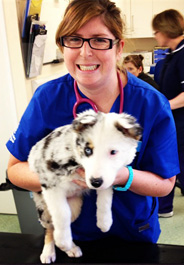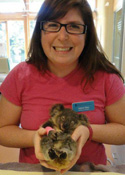A Second Chance
Two Weeks at a British Dog Charity
by Valerie Daru
September 17, 2013
 Veterinary student, Valerie Daru, with one of the dogs fortunate enough to find his way to the UK dog welfare charity, Dogs Trust. Valerie DaruEntering into the bright yellow reception area with walls covered in photographs of happy dog faces, it doesn’t feel like I’m in an animal shelter. It is not a loud and chaotic environment like most overflowing shelters, it is an oasis of calm. There are a few dogs in reception having a lazy nap or padding up for a pat on the head and affection. This is not the kind of place a dog goes for his final days before he is tragically euthanized because of financial constraints, aggressive behaviour, or health issues; this is the place where dogs are saved.
Founded in 1891, Dogs Trust is the largest British dog charity, and has a non-destruct policy. There are 18 rehoming centres nationwide and they house 16,000 dogs per year. The Shoreham by the Sea centre near London, England, where I had the privilege to volunteer, tries to rehome 400+ dogs a year. Many dogs that come to the Shoreham Centre come from dog pounds in Ireland where their policy is to euthanize dogs after five to seven days. This means if you have lost your dog and haven’t phoned the local pounds and shelters, your dog could be truly lost in a week. Some of the dogs who are saved from Ireland are frightened, completely feral with no human exposure, have numerous health issues, and are often pregnant as well.
At each centre, every dog on intake has a behavioural assessment, veterinary assessment, is barrier nursed, and isolated for one week. They are then placed with another dog who complements their personality. Often times the pair are adopted out together because one may be shy and the other one confident, so one dog can give the other courage to be more outgoing and friendly through their newly developed bond. Fortunately, there are many certified behaviour specialists on hand who conduct training so that every dog’s behavioural issues are identified and worked with; continuing on after they are adopted if necessary.
The Dogs Trust is fortunate enough to be able to pay for pre-existing medical conditions for each animal that comes through the door so that the new owner doesn’t have to face the whole financial burden. I found myself absolutely astounded that an old, malnourished Boxer with probable bilateral cranial cruciate ruptures which needed further investigation was taken in by the charity. Dogs Trust pay for everything from dental scaling and extractions to ophthalmic and orthopaedic surgery. Another unique aspect of the charity is that each dog that is not spayed/neutered upon adoption is legally required to come back to the centre for surgery when they are old enough.
As part of my required 26 weeks of clinical work experience, I spent two weeks at the Dogs Trust shelter in Shoreham by the Sea. I came to gain experience in animal behaviour and to practice physical examinations and improve my surgical skills, a goal which Dogs Trust enabled me to achieve.
The most valuable lessons I have learned from these two weeks were the often-disregarded field of animal behaviour. Microchipping and vaccinating can be done without restraint if a little bit of squeezy cheese or peanut butter is spread on the floor to make the animal distracted. Most dogs don’t notice you looking in their ears or poking them with a needle when there’s a far more interesting spread of peanut butter on the floor; it gives them positive reinforcement to make veterinary visits a positive experience.
In veterinary school, animal behaviour does not form a major part of the course, but it is so essential to carrying out our jobs as animal doctors. We get so caught up in instant gratification and following protocols that we don’t stop to think how our actions will affect that dog’s veterinary visits and encounters for the rest of their life. Instead of vaccinating, deworming and microchipping a nervous dog with every single injection on the first visit, the course can be broken up into different visits and the owner can work on practicing handling the dog so that they will be a better patient. Amie, the head dog behaviourist, explained that if the owner handles the dog at home, lifting their gums and practicing vaccination by lifting up the scruff of their neck and using a pen as if they are vaccinating, it can greatly benefit the dog’s behaviour at the vets.
On an international level, Dogs Trust helps in many different countries to spay/neuter animals where there are overpopulation problems. They are also a huge part of Mission Rabies this month, vaccinating 50,000 dogs in India in 30 days. I have previously played a part in Dogs Trust’s international involvement when I was volunteering at a charity on the island of Malta where the organisation was supporting a spay/neuter campaign, and I plan on returning to the clinic in Malta next spring. If other shelters follow the example set by Dogs Trust, then maybe one day all lost and abandoned dogs will get a second chance.
 Valerie Daru Valerie Daru
Valerie Daru is a fifth, and final, year veterinary student at the University of Glasgow, Scotland, but is originally from California. She has volunteered on four HSVMA-RAVS trips and volunteered for animal charities in Australia, Portugal, Cyprus, Greece, Malta, and the UK. |